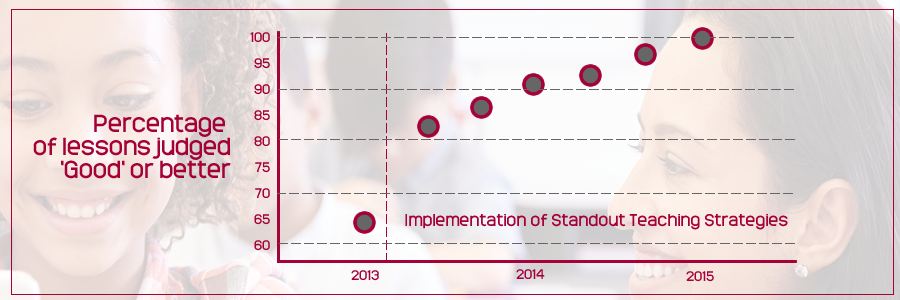
Achieved through a consistent, guided approach to teaching and learning the overall quality of teaching and learning improved to 100% good or better.


The school had been achieving below threshold GCSE results along with a ‘Requires Improvement’ Ofsted grading, which included Teaching & Learning, for several inspection reports. This had placed it in a position of concern leading to HMI visits and LEA intervention. Overall, the quality of teaching and learning lacked consistency with only 65% of teaching considered to be ‘Good’ or better. Ofsted reported inconsistencies commonly found within underperforming schools.
To address the quality of lessons and provide consistency, planning was addressed through the implementation of specific teaching and learning strategies, which were embedded with the use of ‘sketch lesson planning’ used during co-planning sessions. This allowed teachers to ensure their lessons contained each T&L strategy at the correct point during the lesson and allowed teachers to discuss different, student centred approaches to delivering content based around the Student 1st Teaching principals. The outcome was more consistent planning resulting in the quality of lessons across the school achieving 100% ‘Good’ or better.

A core aspect to be addressed in order to raise the quality of teaching and learning, was to provide a consistent, easy to use approach to common teaching strategies.
At a whole school level, a range of key teaching and learning strategies were used, that focussed on readdressing teaching skills so that students could take ownership of their own learning.
The key strategies used were-
Differentiation- ‘GAP’ differentiation, a method of signposting levels of challenge within a task, was used so that students could choose the level of difficulty when undertaking a task to meet their own needs
In-lesson assessment- The ‘BIG’ assessment framework was used to provide structure to feedback which ensured time was allocated within the lesson to ensure that students used this to improve
Lesson objectives- ‘Sky High’ questions were used to reframe lesson objectives into a learning tool that could be used to challenge all students.
Questioning- The ‘Q-Time’ questioning model was used to provide a structure to questioning to maximise its impact within lessons through a focus on thinking time, whole class involvement and open questioning.
Self and peer assessment- To ensure that self and peer assessment was focussed on specific points to support learning, the ‘Green Pen’ strategy was used in conjunction with the ‘Connect’ literacy strategy to provide structure to feedback comments. This was then linked to ‘BIG’ assessment to ensure that this feedback was used to improve student work.
Literacy- To support students in developing their literacy skills, a common set of learning techniques were used across all subjects so that students became experts in their use, this was known as the ‘Connect’ strategy.
Used across the whole school, combined with teacher and student training sessions, the strategies were a focus of short, medium and long term planning and provided a consistent, student focussed approach to teaching and learning.
Success indicators:
The use of a common, whole school approach to T&L meant that monitoring could pinpoint the use of these to ensure that they were being used and were also having an impact upon progress.
With a focus on support, the information from lesson and work insights, undertaken not just by SLT but also by all staff, allowed a framework for sharing good practice, providing insightful feedback on how to develop the use of the strategies and provide information to feed into the whole school CPD plan.
Success indicators:
To ensure that the strategies employed were embedded into planning and developed to ensure quality and impact, weekly co-planning and co-coaching sessions were timetabled into the regular meeting cycle to support staff. This was combined with focussed CPD session for individuals, departments and the whole school to continually support and ensure a consistent focus on using the Student 1st Teaching and Learning strategies and ‘sketch lesson planning’ techniques provided.
Success indicators:
All educators are lifelong learners and so are we at Standout Teaching. Our methods and strategies are informed my real life practice and the research of proven practitioners. Our work has been influenced by the following academics and research-
Please choose from one of the options below and take that next step towards engaging lessons!
Take a look at the packages on offer from Standout Teaching to support your drive towards successful lessons